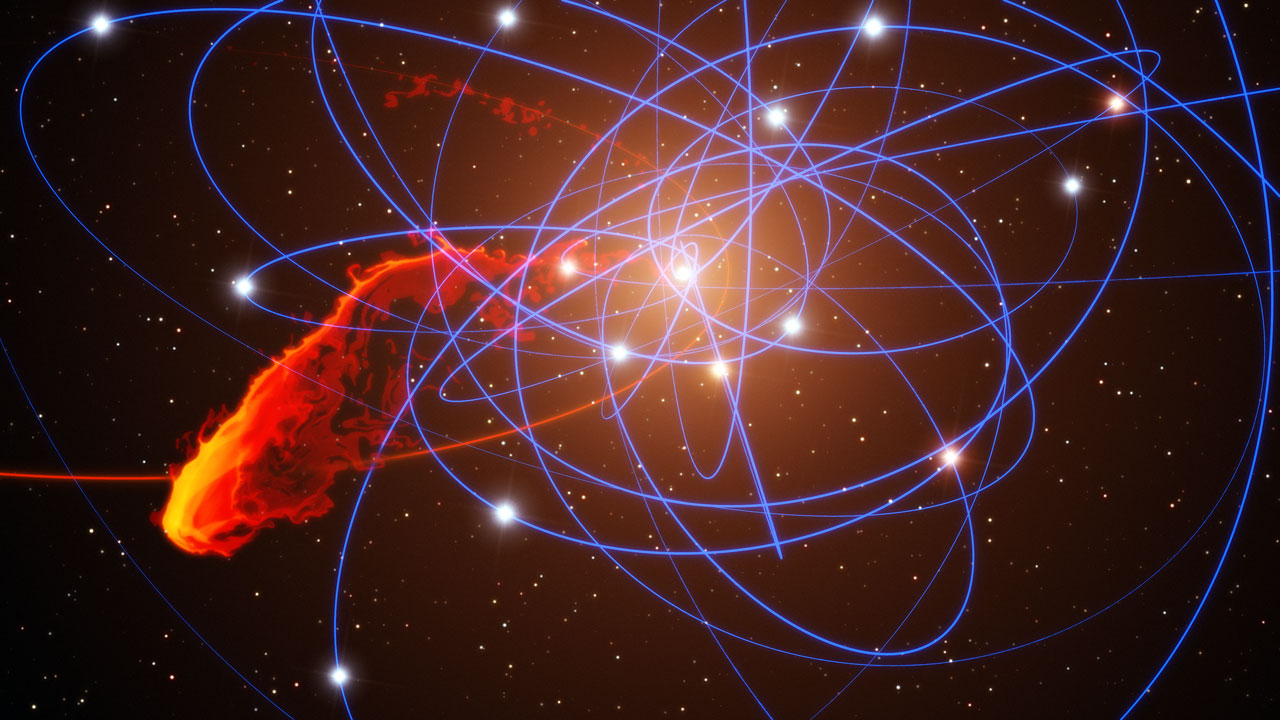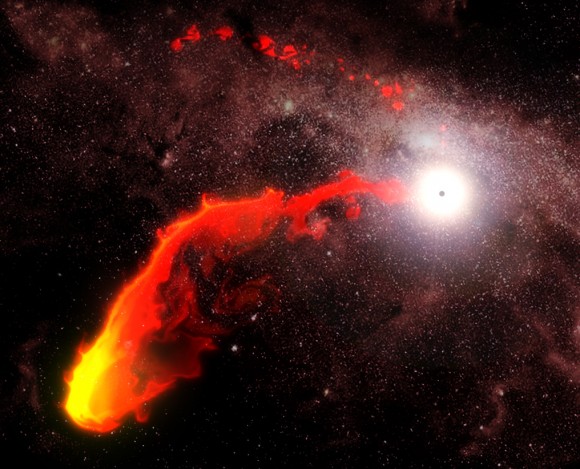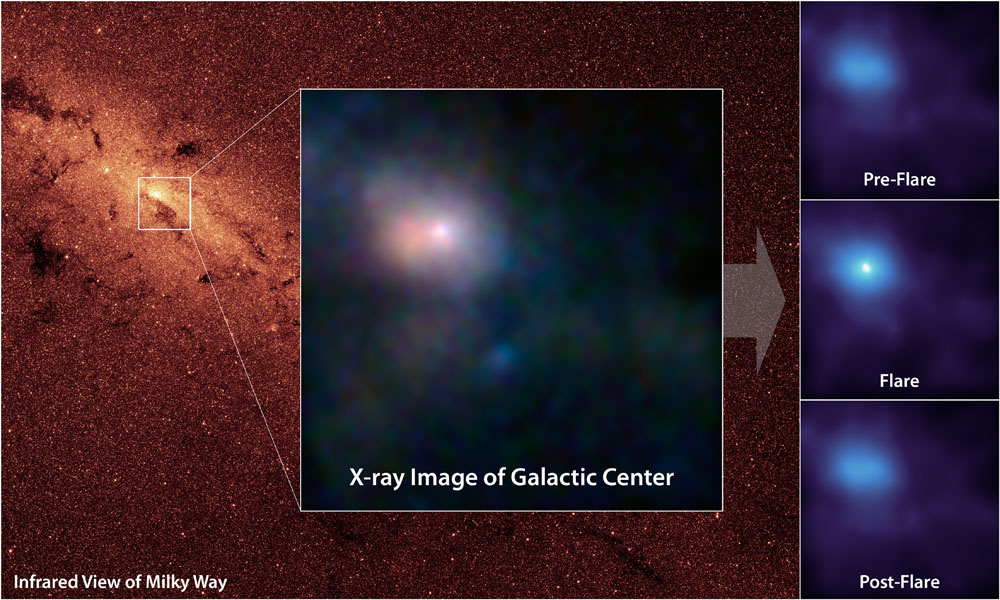European Southern Observatory | 2011 Dec 14
A big meal coming up for galactic black holeVLT spots cloud being disrupted by black hole
Astronomers using ESO’s Very Large Telescope have discovered a gas cloud with several times the mass of the Earth accelerating fast towards the black hole at the centre of the Milky Way. This is the first time ever that the approach of such a doomed cloud to a supermassive black hole has been observed. The results will be published in the 5 January 2012 issue of the journal Nature.Click to play embedded YouTube video.ESOcast 39: A Black Hole's Dinner is Fast Approaching
During a 20-year programme using ESO telescopes to monitor the movement of stars around the supermassive black hole at the centre of our galaxy (eso0846) [1], a team of astronomers led by Reinhard Genzel at the Max-Planck Institute for Extraterrestrial Physics (MPE) in Garching, Germany, has discovered a unique new object fast approaching the black hole.
Over the last seven years, the speed of this object has nearly doubled, reaching more than 8 million km/h. It is on a very elongated orbit [2] and in mid-2013 it will pass at a distance of only about 40 billion kilometres from the event horizon of the black hole, a distance of about 36 light-hours [3]. This is an extremely close encounter with a supermassive black hole in astronomical terms.
This object is much cooler than the surrounding stars (only about 280 degrees Celsius), and is composed mostly of hydrogen and helium. It is a dusty, ionised gas cloud with a mass roughly three times that of the Earth. The cloud is glowing under the strong ultraviolet radiation from the hot stars around it in the crowded heart of the Milky Way.
The current density of the cloud is much higher than the hot gas surrounding the black hole. But as the cloud gets ever closer to the hungry beast, increasing external pressure will compress the cloud. At the same time the huge gravitational pull from the black hole, which has a mass four million times that of the Sun, will continue to accelerate the inward motion and stretch the cloud out along its orbit.
“The idea of an astronaut close to a black hole being stretched out to resemble spaghetti is familiar from science fiction. But we can now see this happening for real to the newly discovered cloud. It is not going to survive the experience,” explains Stefan Gillessen (MPE) the lead author of the paper.
The cloud’s edges are already starting to shred and disrupt and it is expected to break up completely over the next few years [4]. The astronomers can already see clear signs of increasing disruption of the cloud over the period between 2008 and 2011.
The material is also expected to get much hotter as it nears the black hole in 2013 and it will probably start to give off X-rays. There is currently little material close to the black hole so the newly-arrived meal will be the dominant fuel for the black hole over the next few years.
One explanation for the formation of the cloud is that its material may have come from nearby young massive stars that are rapidly losing mass due to strong stellar winds. Such stars literally blow their gas away. Colliding stellar winds from a known double star in orbit around the central black hole may have led to the formation of the cloud.
“The next two years will be very interesting and should provide us with extremely valuable information on the behaviour of matter around such remarkable massive objects,” concludes Reinhard Genzel.
- Notes:
- The black hole at the centre of the Milky Way is formally known as Sgr A* (pronounced Sagittarius A star). It is the closest supermassive black hole known by far and hence is the best place to study black holes in detail.
- The observations were made using the NACO infrared adaptive optics camera and the SINFONI infrared spectrograph, both attached to the ESO Very Large Telescope in Chile. The centre of the Milky Way lies behind thick dust clouds that scatter and absorb visible light and must be observed at infrared wavelengths where the clouds are more transparent.
- A light-hour is the distance that light travels in one hour. It is a little more than the distance from the Sun to the planet Jupiter in the Solar System. For comparison the distance between the Sun and the nearest star is more than four light-years. The cloud will pass at less than ten times the distance from the Sun to Neptune from the black hole
- This effect well known from the physics of fluids and can be seen when for example pouring syrup in a glass of water. The flow of syrup downwards through the water will be disrupted and the droplet will break apart — effectively diluting the syrup in the water.
A gas cloud on its way toward the super-massive black hole in the Galactic Centre - S. Gillessen et al
- Nature (online 2011 Dec 14) DOI: 10.1038/nature10652 (eso pdf)
Max Planck Gesellschaft | 2011 Dec 14
Astronomers discover a gas cloud which will soon be swallowed up by the object Saggitarius A*
At the moment, the black hole at the heart of the Milky Way is going hungry. But its diet may soon be over: a gas cloud has ventured too close to the super massive black hole and will be devoured by it over the next few years. The feeding of the black hole will be observed by astronomers at first-hand, who should also be able to note a largely increased X-ray emission at the time. Even now they can see how the huge gravitational pull of the black hole is causing some distortion to the gas cloud. The cloud was discovered by an international team of astronomers led by the Max Planck Institute for Extraterrestrial Physics.
On a clear night, a shimmering band appears to span the skies: the Milky Way. It is part of our galaxy – that system of gas and dust and at least 200 billion stars, of which our sun is also a member. The constellation Saggitarius (from the Latin for the Archer), is particularly rich with stars. Here, hidden behind cosmic clouds, lies the centre of our galaxy. This is where astronomers observe the strong radio source Sagittarius A*. And the scientists suspect that behind it resides a black hole.
At the heart of our Milky Way resides a black hole with about 4.3 million solar masses, as has been proven with long term observations of the motions of stars orbiting this gravitational monster.
At a distance of 26,000 light years, Sagittarius A* is the only super massive black hole close enough to be observed it in detail. Long-term studies of the stellar orbits around this gravitational monster show that it has about 4.3 million solar masses. For most of the time, the black hole lays dormant, emitting modest flares only occasionally. While black holes cannot emit radiation directly by their very nature, the emission from the galactic centre originates from matter falling towards the event horizon, releasing potential energy and heating up.
Analysing very sharp images and detailed observations of the galactic centre with the Very Large Telescope of the European Southern Observatory (ESO), the astronomers have now detected for the first time a gas cloud that is falling into the accretion zone of the black hole. The scientists discovered that the orbit of the cloud is highly eccentric. In the year 2013, it will be closest to the black with a distance of 40 billion kilometres – a very close encounter in astronomical terms.
“Only two stars so far have come that close to the black hole since we started our observations in 1992,” says Stefan Gillessen, lead author of the paper describing the detection and analysis of the gas cloud. "The crucial difference to these stars - that passed unharmed through their closest approach - is that the gas cloud will be completely ripped apart by the tidal forces around the black hole." As a result the gas inflow into the black hole should increase substantially, as should the level of radiation from it.
The gas cloud can be seen in all long-wavelength infrared images from 2002 onwards, and for the past three years already shows signs of being disrupted. As the cloud falls towards the black hole – its current velocity is about 2350 kilometres per second – it will interact with the hot gas present in the accretion flow around the black hole and become disrupted by turbulent interaction.
“Because the mass of the gas cloud is larger than the mass of the hot gas within the area of closest approach to the black hole, the accretion near the event horizon will be temporarily dominated by the accretion of the cloud itself,” explains Reinhard Genzel, director at the Max Planck Institute for Extraterrestrial Physics and head of the galactic centre research group. “This will provide stringent constraints on the physics of black hole accretion, since we have an unusually good knowledge of the mass available.”
In 2013, the distance of the gas cloud to the black hole will be 36 light hours, which is about 3100 times the event horizon of the black hole. In terms of our solar system, this would be about 250 times the distance Earth-Sun, and the event horizon of the black hole is about 20 times the size of the Sun but with a mass 4.3 million times larger.
As the gas cloud falls towards the black hole, the hot gas present in the accretion disk around the black hole is expected to drive a shock wave, which will slowly compress the cloud. This will lead to a growing, dense shell surrounding the inner zone of the gas cloud. Due to the black hole’s tidal forces, the cloud becomes elongated along its direction of motion, until it is completely disrupted due to instabilities at the contact area.
Just before pericentre the gas cloud intersects with the shock front and the post-shock temperature may increase rapidly to several million Kelvin. This should lead to increased emission in particularly in high-energy X-rays.
Due to the long-term observations at many different wavelengths, the astronomers can constrain the properties of the cloud very well. The temperature of the warm dust cloud is about 280 °C and its density is 300 times greater than that of the surrounding hot gas, with a total mass of about three Earth masses (1.7 10^25 kg). With this information, the scientists were able so simulate the time evolution of the size and velocities in a model, the main effects being the gravitational pull of the super massive black hole and the interaction with the surrounding hot gas.
From this simulation and hydrodynamic calculations, the astronomers predict that the temperature of the gas cloud should increase rapidly to several million Kelvin near the black hole, leading to X-ray emission that should initially be somewhat larger than the current X-ray luminosity of the galactic centre. Over the following years it could potentially brighten by a large factor.
“Detailed observations of the radiation from the galactic centre over the next years will give us the unique opportunity to probe the properties of the accretion flow and observe the feeding process of a super massive black hole in real time,” predicts Stefan Gillessen.
Galactic Black Hole disrupts Gas Cloud
Max Planck Institute for Extraterrestrial Physics | 2011 Dec 14
Warning: Black Hole Dead Ahead!
Science NOW | Ken Croswell | 2011 Dec 14
Disaster looms for gas cloud falling into Milky Way’s central black hole
University of California, Berkeley | 2011 Dec 14






